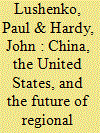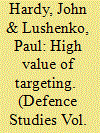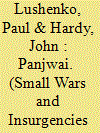|
|
|
Sort Order |
|
|
|
Items / Page
|
|
|
|
|
|
|
| Srl | Item |
| 1 |
ID:
143925


|
|
|
|
|
| Summary/Abstract |
The concept of order in regional security is often characterized as hierarchical, consensus-based, or some hybrid middle-road. The debate largely focuses on how major powers, specifically China or America, can individually build an accommodating order. This article explores the causation of order-building in reverse by asking if the Sino-US relationship can create order as a by-product of individual attempts to build and manage security. It examines Chinese and American responses to North Korea and the South China Sea to demonstrate that order can be constructed through a complex set of negotiated interactions, which encompass cooperative, hierarchical, and consensus-building approaches to order-building. This “unhappy coexistence” implies that order as a by-product of state interaction is a useful but incomplete framework to understand security order-building.
|
|
|
|
|
|
|
|
|
|
|
|
|
|
|
|
| 2 |
ID:
114616


|
|
|
|
|
| Publication |
2012.
|
| Summary/Abstract |
There is a common theme in literature about High-Value Targeting (HVT): that it does not work. In order to make an informed judgment on the use of HVT in irregular war against networked opponents, an accurate analytical framework is required. This article proposes a conceptual model that recognizes HVT as: subordinate to strategic objectives, a shaping and enabling tool, rather than a decisive tool, and fuelled by a robust, intelligence-led targeting cycle. It identifies three methods of conducting HVT: pressuring, leveraging, and desynchronizing, and argues that there is a significant and underappreciated potential for complementarity between HVT and non-kinetic operations in irregular warfare.
|
|
|
|
|
|
|
|
|
|
|
|
|
|
|
|
| 3 |
ID:
144332


|
|
|
|
|
| Summary/Abstract |
The US Army has two approaches to counterinsurgency operations in Afghanistan. One is hard, or combat-focused, and the other is soft, or development-focused. This study examines two US Army task forces deployed to Panjwai District, Afghanistan from 2012 to 2013. CTF 4-9 and 1-38 offer a meaningful comparison because they pursued these contrasting approaches among the same population and against the same enemy at the same time and place. The study compares each unit’s approach and finds that neither approach was successful absent the other. The article concludes by recommending further research into combining the approaches at the operational level.
|
|
|
|
|
|
|
|
|
|
|
|
|
|
|
|
|
|
|
|
|